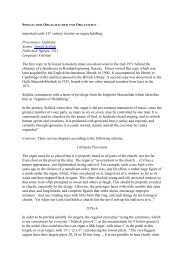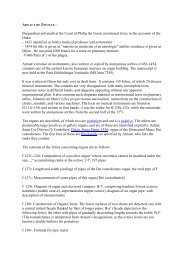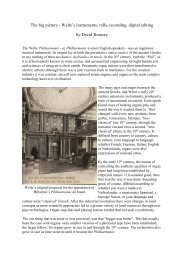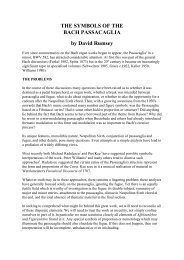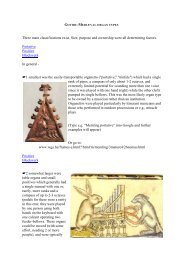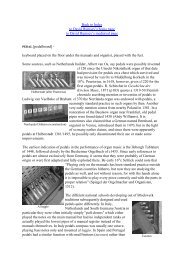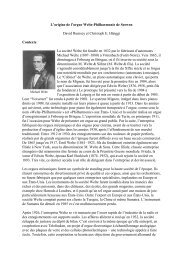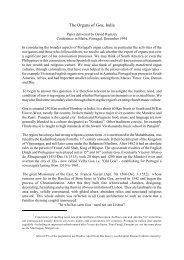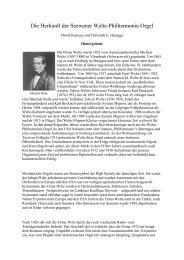Bach and the Holy Trinity - David Rumsey
Bach and the Holy Trinity - David Rumsey
Bach and the Holy Trinity - David Rumsey
You also want an ePaper? Increase the reach of your titles
YUMPU automatically turns print PDFs into web optimized ePapers that Google loves.
10<br />
similarity of Affekt <strong>and</strong> Figur <strong>and</strong> <strong>the</strong> echoing, i.e. reproducing or making in its image, of<br />
<strong>the</strong> "Fa<strong>the</strong>r" <strong>the</strong>me) <strong>and</strong> <strong>the</strong> second part of it betokening God made Man (<strong>the</strong> associations<br />
with <strong>the</strong> musical language of Passion <strong>and</strong> Crucifixion).<br />
The third <strong>the</strong>me is a descent of one octave, recalling for us <strong>the</strong> sphaera octava, or octave<br />
of <strong>the</strong> spheres, which since ancient Greece, through <strong>the</strong> polymaths such as Henri Arnaut,<br />
<strong>the</strong> era of Newton, Viviani <strong>and</strong> Kepler, was a symbol for <strong>the</strong> relationship between <strong>the</strong><br />
cosmic bodies, especially heaven <strong>and</strong> earth. The elaborated moving about in <strong>the</strong> lower<br />
tessitura is an ideal representation of <strong>the</strong> <strong>Holy</strong> Ghost on earth, also used by <strong>Bach</strong> in o<strong>the</strong>r<br />
contexts.<br />
Not only do <strong>the</strong>se <strong>the</strong>mes provide most appropriate representations but <strong>the</strong>y are<br />
introduced in <strong>the</strong> normal order of Fa<strong>the</strong>r first, Son second, <strong>and</strong> <strong>Holy</strong> Ghost third. The<br />
Prelude is immediately followed by three pieces textually identified specifically with<br />
Fa<strong>the</strong>r, Son <strong>and</strong> <strong>Holy</strong> Ghost, again in that order. These are followed by three smaller<br />
versions with identical titles in identical order.<br />
The unusual choice of key for <strong>the</strong> Prelude - <strong>Bach</strong>’s only free organ work in E� major -<br />
th<br />
invites attention. This key was normally out of <strong>the</strong> question for 18 century composers<br />
on account of <strong>the</strong> keyboard tempering <strong>and</strong> tuning practice of <strong>the</strong> day: its sub-dominant,<br />
A� major, was a tense <strong>and</strong> out-of-tune key suitable only to provide Affekten of agony, but<br />
o<strong>the</strong>rwise normally avoided. The beginning of “Thy rebuke has broken his heart” from<br />
H<strong>and</strong>el’s Messiah is an example of <strong>the</strong> deliberate use of dissonant A� major, colouring<br />
<strong>and</strong> interpreting <strong>the</strong> text. But <strong>the</strong> key signature of E� major is a 3-symbol of its own<br />
accord for it indicates to <strong>the</strong> performer that three notes in each octave are to be read as<br />
flattened accidentals. Moreover <strong>the</strong> tension <strong>and</strong> dissonance from <strong>the</strong> A� major tonality<br />
<strong>and</strong> beyond are specifically used in <strong>the</strong> second <strong>the</strong>me, second part, <strong>the</strong> one which seems<br />
to represent <strong>the</strong> human nature of Christ.<br />
An interesting point of Biblical numerology also comes out in this “human” <strong>the</strong>me in that<br />
it has a most unusual ornament - technically termed an appoggiatura, a short grace-note<br />
used to add an Affekt of sighing, or longing - human attributes, passion attributes. The<br />
unusual thing about <strong>Bach</strong>’s appoggiatura in this case is that instead of being <strong>the</strong> normally<br />
adjacent note, he writes one which leaps a fifth. According to Werckmeister in early 18th<br />
century, <strong>and</strong> Schmidt in Biblische Ma<strong>the</strong>maticus of 1736 - just 3 years before <strong>the</strong> piece<br />
we are discussing was composed:<br />
“5 is associated with weakness or Fall of Man”.<br />
So we can see in this Prelude a confluence of Biblical symbolism <strong>and</strong> o<strong>the</strong>r numerology,



